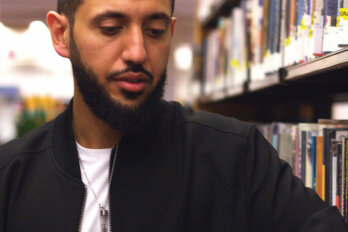This is the story of a sexual assault trial with only two witnesses: the accuser and the accused. At least one of them is lying. The other may or may not be telling the whole truth. The law states that it is possible to convict under such circumstances, even when there is no forensic evidence. But the law doesn’t make the truth easy to discern, which is why the verdict has been appealed.
The email was sent to an address listed on the Toronto Police Services website. Its subject line read, “Something awful happened to me last night.” Although it was successfully delivered on July 31, 2012, no one opened or read it until more than six months later in January 2013, by which time the anonymous sender had given up hope of ever hearing back from police. She had used an old Chinese email account and stopped checking it until, on a whim, she opened it up in August 2013.
“What you have described below is a very serious event,” said the email sent from 52 Division in downtown Toronto. “If you wish the police to assist you in filing a report you will have to identify yourself because of the serious nature of this event. You can call 416 808 2222 and a police car will come to see you.”
As she read the email, her boyfriend saw her reaction and asked what was wrong. Until then she had never told anyone about what had happened to her. She passed him the iPad she was using so he could see both the original message and the police response. “We have to report this,” he said. Then he called the number on the email and asked for the police car to pick them up.
There was another mix-up and no car arrived. Instead of being taken to 52 Division, she and her boyfriend headed to the nearest north Toronto police station. There, he told a duty officer, “This girl was raped last summer and we want to report this.” The officer asked if they needed a Chinese interpreter and they said yes. When the interpreter arrived a few hours later, “Cecilia”—whose real name cannot be revealed due to a standard publication ban that protects the identities of complainants in sexual assault cases—gave a statement.
At the end of September, police arrested the accused. His mugshot was splashed all over both English and Chinese language media as the police called for other possible victims to come forward. After word reached his employers, he was fired from his job. He says he was in a state of shock unable to even figure out who his accuser was until his bail hearing. Although there are no legal prohibitions against revealing the name of the accused, he will, in this account, be known by the pseudonym “Li Peng.”
This is not a murky sexual assault case about whether consent was given or signals misinterpreted. The two versions of what happened, as related by accused and accuser, are completely incompatible. She says he raped her. He says he never touched her. At least one of them is lying. Almost all of the evidence, whatever there was, is long gone.
Li’s trial begins on June 30, 2015, at the Superior Court of Justice in downtown Toronto. Over two days of testimony, there are just a handful of facts on which Cecilia and Li agree. Neither disputes that they met on Momo, a Chinese-language messaging app. Or that he told her he was a photographer, that she wanted to be photographed, and that the photo shoot was the only time they ever met. Their accounts begin to diverge when they are asked who initially contacted whom. She says he’s the one who first messaged her on Momo. He says she reached out to him.
Lisa White, Li’s lawyer, puts it to Cecilia that Momo is known as a dating app with location-finding capabilities. White’s description makes it sound like a Chinese version of Tinder, best known for helping users hook up with others nearby. The implication is that the complainant was looking for romance.
Cecilia says she used Momo for “friend making.” She was bored back then and, as a result, spent a lot of time on social media. She had just finished a year of studies in Toronto and didn’t have a summer job. Her boyfriend was away in China. She was looking for something to do.
Li, on the other hand, was busy at his work where he earned a six-figure salary and often had to put in overtime. He says he was on Momo mainly for his job. As an expert in online user experience, he had been asked to compare and contrast different messaging apps for a client.
The prosecutor, assistant Crown attorney Daniel Brandes, thinks this is an excuse and that Li was using Momo to prey on young, attractive women like Cecilia by putting himself forward as a professional photographer. Li denies that he ever claimed to be anything more than an enthusiastic hobbyist who takes pictures for fun. White asks Cecilia why she thought he would offer his services at no cost if he were a professional. Because, she answers, she was modelling for free.
She describes herself as “a girl who is in pursuit of beauty” who thought it might be “a good idea to have some beautiful photographs taken.” Sometimes she answers White directly in English and at other times she speaks through an interpreter provided by the courts. She says she used a link Li had sent her to check out his Facebook page and was impressed by the quality of his photos. She recognized a schoolmate, who we’ll call “Catherine,” as one of his models so she set up an appointment to be photographed by Li the following week.
According to Li, Cecilia told him in advance she wanted photos in the style of Yasumasa Yonehara, a celebrity Japanese photographer known for both his shots of Tokyo street fashion and his soft porn images, said to be the inspiration for American Apparel’s early advertising campaigns. Li says he told Cecilia to bring colourful clothes so they could emulate “Yone.” Cecilia tells the court that to this day she has never heard of the famous photographer.
“[Li] indicated that I needed to wear something good looking, more sexy,” Cecilia says. “And he also indicated for me to bring some makeup.”
According to Li, he invited Cecilia to come with a friend or a make-up artist. When asked about this by White, she neither confirms nor denies it. For some reason, Li’s lawyer doesn’t press her on the ambiguous response.
On the evening of July 30, 2012, Cecilia showed up alone at Li’s downtown condo. She wore a short black dress and black high heels. She carried an orange Prada purse along with a paper shopping bag in which she had a change of clothes. She was made up for the photo shoot. Building security directed her to wait on a couch in the lobby. Li texted that he was running late and asked if she wanted to cancel, but she said no, she was already there.
When he arrived, he took her up to his condo on the ninth floor. It was an open concept space that he had decorated himself. She recognized a shelf full of collectibles and antiques that she had seen in his Facebook photos. A Hermes belt that was on display stood out.
Li asked her to take a seat. And while she leafed through some fashion magazines, he went to the fridge and poured out tonic water, his summer drink of choice, for both of them. Cecilia says it was an alcoholic beverage, which she didn’t like because at the time she rarely drank. According to her account, Li told her it would help her relax.
They made casual conversation. He says he was taken aback to learn she was eighteen; he had thought from her photos she would be in her twenties. She told him her boyfriend didn’t know she was there and would kill her if he found out.
Li told her where he was from in China, that he had studied in England, that he had a girlfriend, that he owned five properties in Toronto, and that he would sometimes go to the nightclub, Babyface.
“What impression were you left with of Mr. Peng?” the prosecutor asks.
“I thought he was kind of a fashionable avant-garde photographer,” Cecilia says.
When he cross-examines Li, Brandes asks him what he thought when he learned he was almost twice Cecilia’s age, why it didn’t set “alarm bells ringing” when she told him her boyfriend would kill her if he knew she were there.
Li replies that he attributed her comments to her “immaturity.”
“Did it occur to you at that point that maybe this wasn’t all that Cecilia was there for?” crown attorney Brandes asks.
“At that point, no, I didn’t think too much. Like I said, I just attributed it to her immaturity. And in my head, I did think,” Li says, pausing to collect his thoughts, “[that] as a young girl she should not be coming alone.” Unlike Cecilia, he never uses the interpreter.
“Why don’t you say to her at that point, ‘You know what Cecilia maybe this isn’t a great idea . . . for all the reasons you’ve already indicated?’”
“Because she was already there and because I knew nothing would happen and I have nothing to be concerned about, so we just went on with the photo shoot. But what was in my head is let’s take photos quickly and let’s finish. And off we go.”
Before he began taking pictures, Li touched up Cecilia’s make-up, which wasn’t strong enough for a photo session with lights. He added eyeliner and a mole on her cheek, making her look like Lena Fujii, a model she had been admiring in his fashion magazines. Cecilia was pleased with the results.
The resulting photos, which are shown at the trial, are suggestive and provocative. Cecilia lifts up her skirt, sticks out her tongue, grabs items from Li’s cabinet and uses them as props. She holds an antique camera in front of her crotch. Cecilia says he told her how to pose, that she followed his instructions.
Li says she improvised.
During Cecilia’s cross-examination, White says, “You look like you were enjoying yourself. You’d agree you look quite comfortable in those photos?”
“No.”
“No?’ White asks. “I’m going to suggest to you that you looked the least comfortable when you weren’t posing at all—in the first photo.”
“What do you mean by comfortable?”
“You have an almost sour expression on your face when you weren’t posing at all. It’s when you start posing and doing the flirtatious poses that your facial expression changes and you look more comfortable.”
“I don’t think so,” Cecilia says. “That’s your assumption but that’s not true.”
After almost half an hour of shooting photos, Li suggested they take a break. Cecilia says he gave her a drink and told her to have some more. She says she did little more than wet her lips, however, so the drink had no effects.
Li, who had asked Cecilia to bring colourful clothes, was disappointed with her black dress. He looked in his closet for something else she could wear. He says that together they decided she should wear a brand new yellow tank top he had just bought at H&M. Cecilia took it to the bathroom to change.
“I didn’t find that yellow vest good looking at all,” she says, “but I was still thinking that since he is the photographer, he understands better. And I was thinking maybe the purpose is to show the legs in a way to make them look longer.”
Brandes asks Li why he would have Cecilia change into a skimpy tank top if, as he claimed earlier, he just wanted to get the photo shoot over with.
“Because the first set of clothing wasn’t to the spec and I thought we wouldn’t get enough good photos,” he replies. “I still hoped that we could still end up with some good quality photos.”
The prosecutor, who’s a bearded Mandy Patinkin type, seems mystified when Li goes into designer and artist mode. But along with his bachelor’s degree in applied physics and master’s in human computer interaction, Li has a second master’s in visual arts and arts criticism.
“The moment you press click you can tell [if a photo is good or not]?” Brandes asks.
“Yes,” Li says. “I can already tell.” He explains that he wanted more variety.
“Nothing trumps that desire to achieve that artistic goal?” Brandes asks.
Li says it was a two-pronged commitment. He had agreed to take the photos and he wanted them to be good. He also didn’t want to leave Cecilia disappointed.
Brandes points out that the tank top was shorter than the black dress. “You can visibly see her underwear covering her vagina,” he says. It exposed more skin. He asks if that was the goal of the second set of photos.
“Show more skin is part of it,” Li says. “Having a men’s tank top is called ‘boyfriend style’ and that’s a typical fashion style that a lot of Asian girls follow when they take photos.”
“Sorry, you’re saying one of the reasons is because that’s a style called ‘boyfriend style,’” says a flummoxed and apparently fashion oblivious Brandes.
“Right,” Li says.
Brandes can’t believe that the whole situation didn’t make Li uncomfortable. Li says it wasn’t until the photo shoot ended and Cecilia joined him on the couch to look at the photos that things took a turn.
Part 2: “I was stupid, I was young, I was ignorant, and that’s all I admit”




